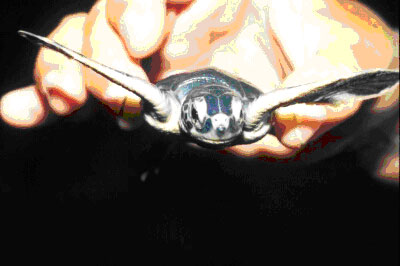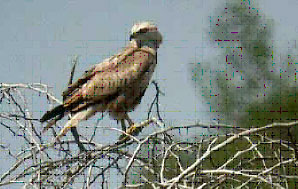Khawrs (creeks) are transitory wetlands that depend on the tides and wadi (dry riverbeds) floods. They are part of the wadi system in that they help drain the surrounding land during heavy rainfall. Some khawrs are wide and shallow and surrounded by sabkha (salt flats), others have deep narrow channels lined with mangrove trees or with reeds or other vegetation. Some khawrs are saline and tidal; others become lagoons when a sandbar seals it off from the sea by a sandbar. There are khawrs all along Oman's coastline.
Oman's coastal area supports huge numbers of migratory and wintering water birds. The numbers can reach 300,000-500,000 birds of 90-110 species at the Barr Al Hikman.
Birdlife International has identified 33 sites of special importance for bird conservation in Oman. Eight are terrestrial sites, and nine are offshore islands or coastal headlands, 16 sites are coastal wetlands. The volunteer Oman Bird Group carries out studies of bird populations in the Sultanate.
Wetland areas:
1) Batinah Coast: here are three major mangrove-lined tidal creeks: Khawr Kalba, Khawr Shinas and Khawr Nabr and a number of smaller creeks in wetlands along 300 km of Oman’s north coast. This area isimportant for passage and wintering water birds: shorebirds, gulls and terns. The creeks support mollusks, shellfish, and fish.
Khawr Kalba, on the border between Oman and the United Arab Emirates, is the only breeding site in the Arabian Peninsula of the Booted Warbler.
Khawr Shinas, about 30 km south-southeast of Kalba along the coast, is a 6 km long tidal creek. Dense stands of mangroves line the southern part. The northern part is blocked by a causeway.
Khawr Nabr, which lies a further 25 km to the southeast, is a 3 km long tidal creek, divided by channels lined with mangroves. There is one exit to the sea near the village of Sahi Harmul.
The creeks contain some of the finest remaining stands of the Dwarf or Black Mangrove in Oman, and support about 30 species of birds.
2) Barr Al Hikman and Masirah Island Barr Al Hikman lie about 350 km south of Muscat.
This is an extensive area of mudflats, shallow lagoons, sea bays and straits, together with a number of offshore islets, a small area of mangrove and sandy beaches. The site has been proposed for protection in several National Nature Reserves for its importance for nesting sea turtles and bird population. Four species of sea turtles, Loggerhead, Green Turtle, Hawksbill and Olive Ridley, come ashore to nest, and a fifth species, the Leatherback Turtle, visits the area. Surf Beach, on the eastern shore of Masirah Island, is a nesting site of world importance with an estimated 30,000 females coming ashore each May-September. The seagrass that grows in this area is an important food source for the turtles.
The area’s mammals include the Arabian Gazelle and the Cape Hare.
3) Ad Duqm on the south-central coast of Oman is a shallow sea bay with coastal lagoons and mudflats, important for migratory and wintering waterfowl, especially shorebirds, gulls and terns. 30-40 species of birds are found here.
4) Khawr Dhirif on the Sahil al Jazir coastal plain of south-central Oman is a small land-locked fresh water lagoon with vegetation, surrounded by sandy terrain.
The lagoon is part of the proposed North Jazir National Nature Reserve which is part of a proposed Natural World Heritage Site.
5) Khawr Shumayr (Ghawi) on the southeast coast of Oman is a large tidal inlet with mudflats, important for migrating herons, flamingos, shorebirds, gulls and terns.
This area was protected by Royal Decree in 1994, as part of the Arabian Oryx Sanctuary. The site has been identified as an Important Bird Area by BirdLife International.
6) The Dhofar Khawrs and Wadi Darbaat is a chain of 12-15 khawrs on the Salalah Plain, along a 45 km stretch of coastline in southern Oman. They are rich with aquatic fauna and flora. Khawr Rawri (1,100 ha), is larger than all others combined. It is about 2.6 km long and receives its water from Wadi Darbaat.
This area also has been proposed for designation as a National Nature Reserve, for its scenic, historic and wildlife value.
Mammals found in Dhofar include Leopard, Wolf, Honey Badger White-tailed Mongoose, Genet Striped Hyena and porcupines.
The dangers to the khawrs include urban development and with it the construction of roads which will bring more people to these areas. Grazing by cattle, camels, sheep and goats occurs all year round. During the monsoon additional animals are brought down from highland pastures there.
Almost all of the sites lie within the proposed system on Nature Conservation Areas. A large area of Oman’s Central Desert region has been proposed as a Natural World Heritage Site.
sources: www.wetlands.org; www.biodiv.org/doc/world/om
photo sources: www.surfbirds.com/mb/trips/oman ,
www.picturesofplaces.com/Asia/oman





